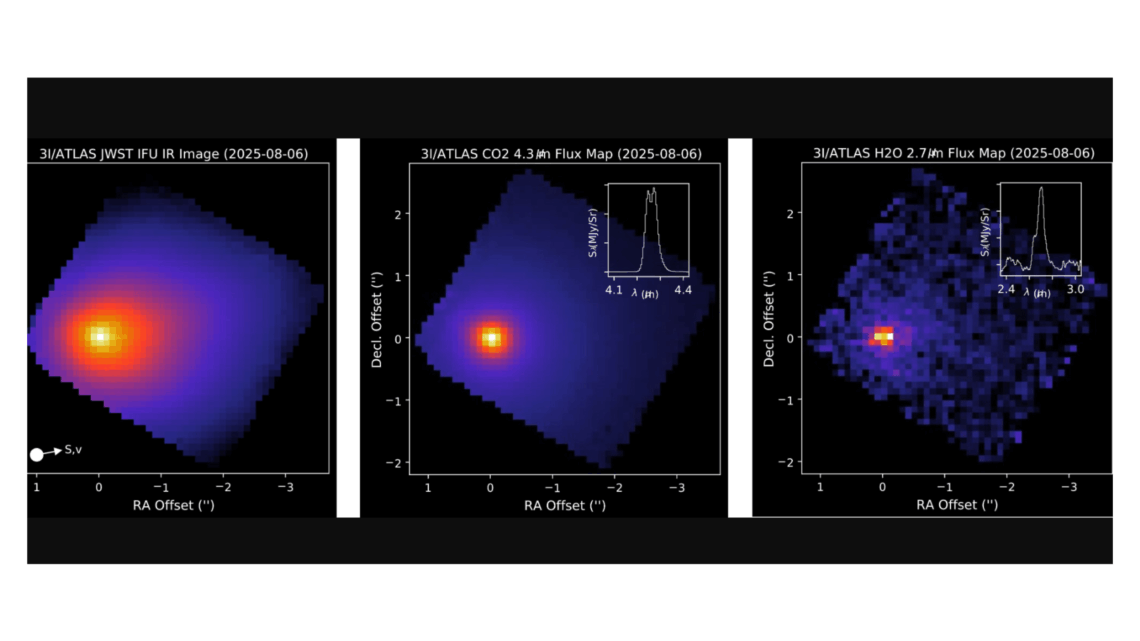When the faint object now known as 3I/ATLAS was first detected by the ATLAS telescope in Hawaii earlier this year, astronomers classified it as another comet. Within weeks, it became clear that this visitor was far from ordinary. Its trajectory, chemistry and activity patterns have made it one of the most puzzling interstellar objects ever recorded — and, for some, a possible sign of something artificial.
3I/ATLAS is only the third confirmed interstellar object known to have passed through our solar system, following the discoveries of 1I/ʻOumuamua in 2017 and 2I/Borisov in 2019. Its speed and open, hyperbolic orbit indicate that it did not originate from the Sun’s gravitational family and will never return once it departs.
A Comet That Breaks Familiar Rules
Observations from NASA’s James Webb Space Telescope have revealed a chemical composition that differs sharply from that of most comets. The object’s coma — the cloud of gas surrounding it — contains an unusually high concentration of carbon dioxide relative to water vapor, about eight to one, according to an August 2025 analysis. Scientists note that such a ratio has not been seen in any other known comet within the solar system, implying that 3I/ATLAS may have formed in an exceptionally cold and carbon-rich environment around another star.
Even more perplexing, NASA data released in September showed the comet releasing water vapor while still well beyond the orbit where sunlight typically causes such sublimation. The detection of water activity so far from the Sun has challenged existing models of cometary behavior and raised questions about the physical processes driving it.
The Hypothesis of Artificial Origin
The combination of a rare trajectory, unexpected activity and anomalous chemistry has prompted a handful of researchers to suggest that the object may not be entirely natural. They argue that certain reflective and orbital properties could indicate engineered materials or deliberate motion rather than random gravitational scattering.
Supporters of this idea note that the comet’s orbital path passes unusually close to several planets, including Venus, Mars and Jupiter, which some interpret as an improbable alignment for a purely random visitor. They point to similar discussions that followed the discovery of ʻOumuamua, whose acceleration and shape once sparked speculation about extraterrestrial technology.
Mainstream researchers, however, regard the alien-probe hypothesis as highly speculative. They emphasize that compositional and structural differences are expected in objects that formed under unfamiliar stellar conditions. Planetary scientists generally see the evidence as consistent with a natural body — an interstellar comet that simply reflects the diversity of environments in the Milky Way.
Searching the Edges of the Possible
Regardless of its true nature, 3I/ATLAS offers a rare opportunity to study matter from beyond the solar system. Each interstellar object carries chemical signatures of another planetary nursery, providing clues about how common — and how varied — planetary systems might be throughout the galaxy.
The debate surrounding its origins reflects a broader shift in space science: a growing willingness to consider unconventional explanations alongside traditional ones. The distinction between what is merely unexplained and what is extraordinary remains crucial, but the boundaries of inquiry are widening.
As 3I/ATLAS swings behind the Sun in the coming weeks, observatories across the world are racing to capture final data before the comet fades from view. Soon it will leave the solar system behind, carrying with it the unanswered questions that have followed it since its discovery — whether it is a frozen relic of a distant star, or a silent messenger built by hands not yet known.
The post The Alien Question Hiding Behind 3I/ATLAS’s Faint Green Glow appeared first on International Business Times.




